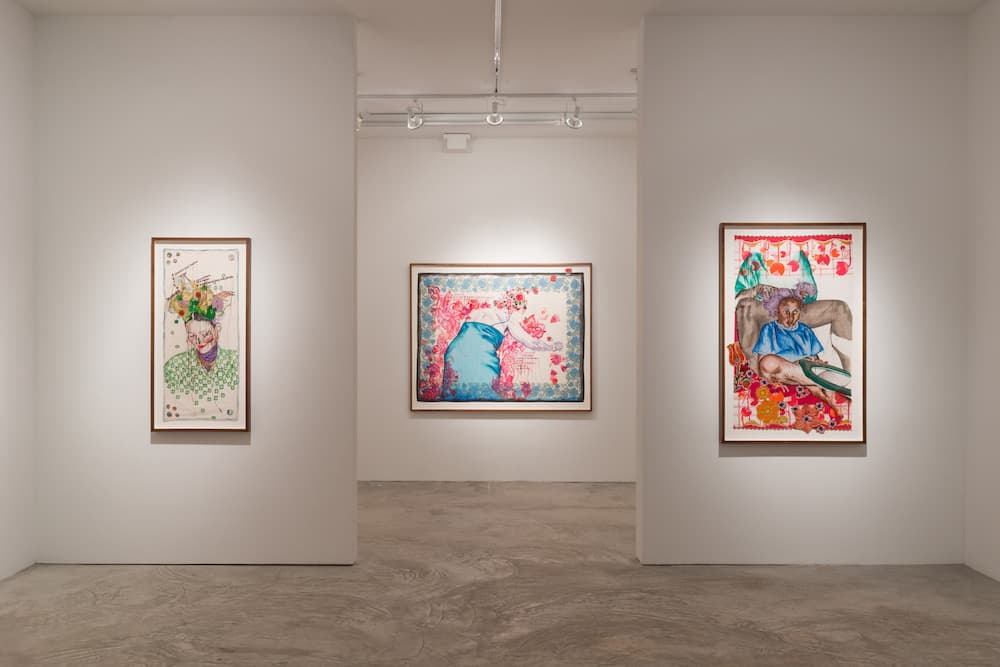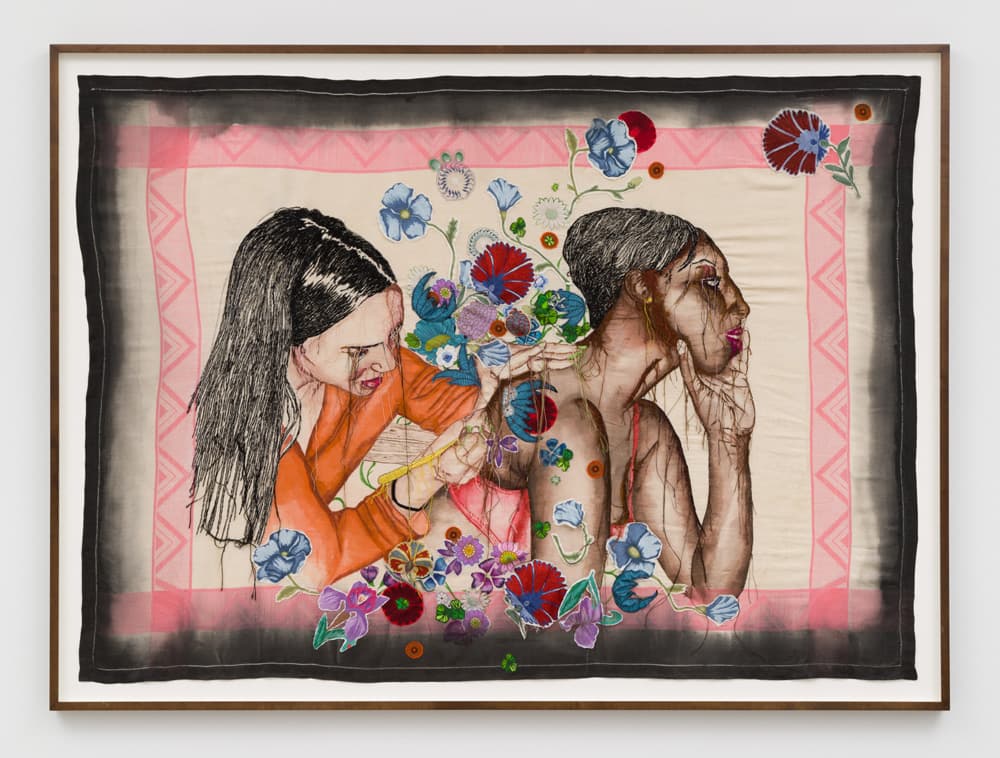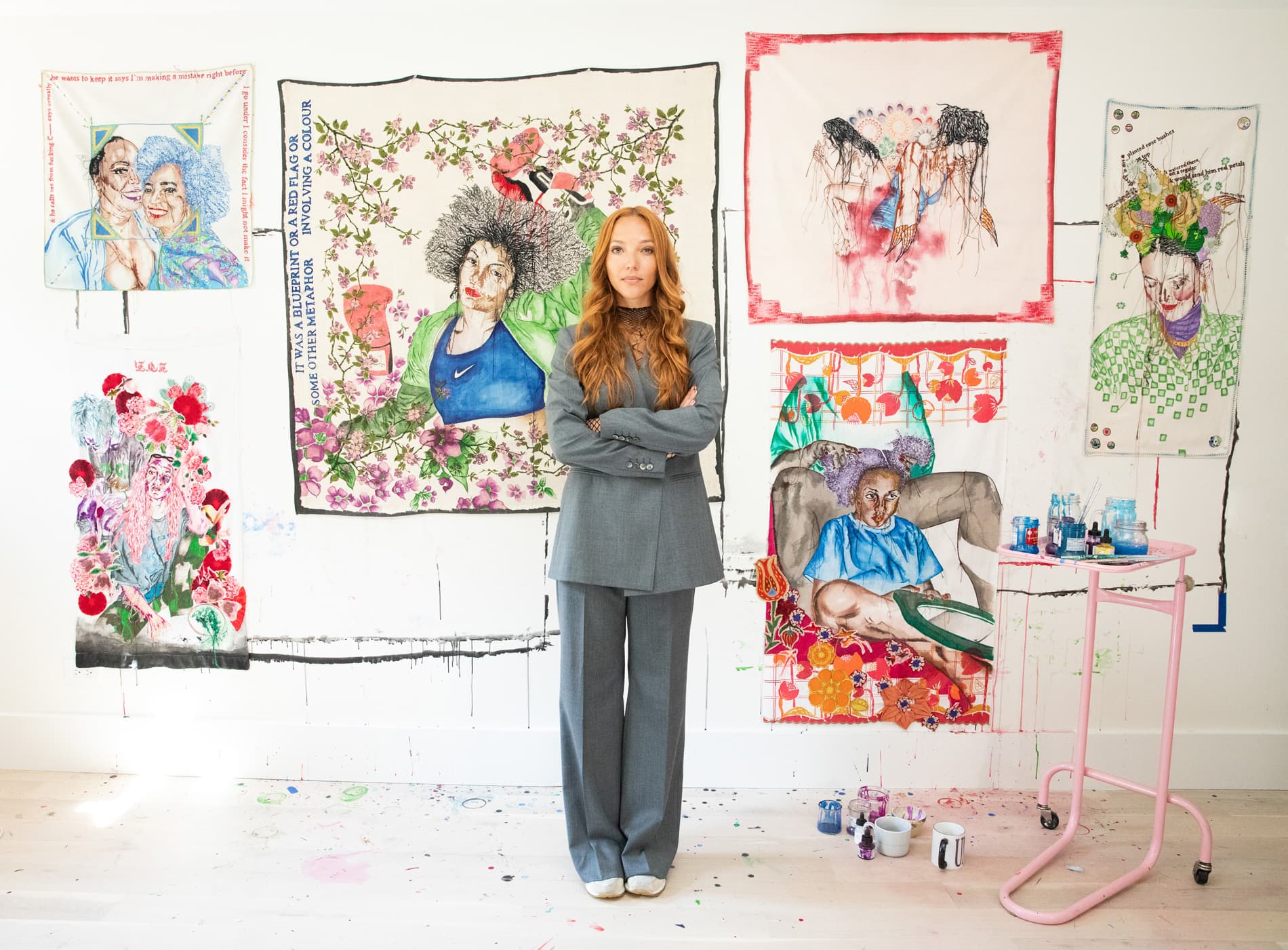Published September 25, 2023
Zoë Buckman’s Embroidered Scenes Pulse with Pain and Poignancy
Emerging from the darkness of her past, prolific British artist Zoë Buckman has put the rage, anger, and gritty intensity of her previous works aside to present a new body of category-defying portraits that bloom with possibility and untamed power. After years of coping with the feelings of loss, pain, and grief so often tied to the female experience, Buckman professes, “I would like no more source material to deal with trauma.” Marking a new artistic direction, the eleven lusciously vibrant mixed-media works in TENDED celebrate the female support systems that have nurtured Buckman over the years, watering her soul to renewal. The subjects in these scenes weep, smoke, ache, dance, box, bond, and roar, reminding us that the full spectrum of emotion is part of living and that we are all in this life, together. Two weeks into her first solo show with Lyles & King, the artist and I sat down for a conversation over Zoom to discuss the gestation of these works and the evolution of her inimitable practice.

I want to give you the chance to choose where we begin the conversation today because this is really an opportunity for you to talk about your show. Where do you want to start as we dive into these emotive, personal pieces?
ZB: I think this show really marks a progression of my practice because this is the first time I've done an exhibition in just one discipline, one type of artwork on display. In the past, I've done shows where I have hanging sculptural works as well as embroidery works. Or I might use quilting and then have a sculptural piece. In my last show in New York, Heavy Rag in 2019, I had textile sculptures that hung from the ceiling, flat textile works on the wall, and small ceramic works that I made by hand. I’ve really liked keeping a boundary for this show; it’s helped me explore one central idea. I’ve also never made work this large. These are all hand-embroidered pieces and it’s very labor intensive, so this is the biggest I’ve been able to achieve.
From an emotional standpoint, this show is also a new direction for me in terms of how I'm examining trauma, violence, and oppression, and a lot of the experiences in the body that are particularly difficult. I think it comes as a result of my own personal journey processing and healing and contextualizing those experiences in my work over the years. It’s a vulnerable state of newness I’ve entered into, and I’m happy to get more into that later on.
The amount of energy you’ve put into this show—both emotionally and physically—very much comes across in the work. The sheer level of detail in every piece is tremendous, and I think the viewer can really sense your vulnerability in the creative process. There’s such a depth and range of feeling in every work. Could you talk about where you begin when making a particular piece? Where do these rich scenes and evocative images come from? Where do you source the gorgeous textiles?
ZB: Absolutely. So all of the scenes represented in this show come from fleeting, captured moments that I’m either in, or that I’ve captured myself. I don’t invite people into my studio to do a formal sitting or stage anything, and that’s not to throw shade on formal portraiture. I’m in the moment in all these scenes because I was literally part of that memory. The very last piece I made in this series—also the largest—is called songs leak from my bedroom walls. It’s inspired by a photo my brother took of my sister-in-law and me back when I was seventeen or eighteen and I was drawing on her back. That was the year I lost my virginity. My bedroom was the tiniest room in our house in Stoke Newington in Hackney, East London and I remember how anyone who ever came into my room, we would have to pile onto my bed because it took up the entire room. My memories of that time are so strong, I’ve kept the negative of the photograph for 20 years now.
As part of my practice, I collect (well, hoard!) vintage textiles of all kinds from all over the world. My studio is literally like the Beacon’s Closet of tablewares. But I ran out of tablecloths that I was compelled to use, so I went out looking for one that felt right to depict this particular moment.
The fabric in this specific tablecloth is technically called damask and it’s pretty fancy—this style of weave traces back to the Byzantine empire. When I found it, I saw it had this light pink border around it which is really rare. I was instantly like, this is beautiful and yummy, and one that I want to fuck with. So I pinned it up on my studio wall and painted the two figures in ink.
In this series, I’m looking at these tender moments in life, both recent and in the past, and I really wanted to touch on my relationship with this woman which began decades ago. What I’m trying to do in this piece is capture all of the possibility we had in that moment. She was only my brother’s girlfriend at the time but there was so much to come that we weren't aware of, the good and the bad. She’s been there for me through thick and thin as a steady source of support. Through marriage, divorce, the death of my mom (which affected her almost as much as it did my mom's biological children), pregnancy, abortions, miscarriages, heartbreak, all of the things. I also depict her daughter and my own in other works in the show, and so by adding the flowers in this piece, which are stemming from my pen, I’m perhaps looking at my own artistic journey as well as our personal growth as women and as mothers. I could’ve represented this moment in a sorrowful way, but I'm not doing that here. Yes, there’s trauma and there's violence and there's injustice, and that's all really fucked up. But there is also this steady thread of joy and community and growth in my life, and that’s what I’m wanting to show.

I’m glad you brought up songs leak from my bedroom walls because I wanted to ask you about the lyrical quality of your work. These are deeply personal moments you’re depicting, memories that are yours and yours only, and yet you’ve put this bittersweet nostalgia into a visual language that feels universal somehow. Song-like almost.
ZB: Yes! Thank you for picking up on that because music is so important to me. When I think back on being seventeen or eighteen, like I was in that image, or even early teens, so many of those memories, at least for me, are underpinned with what I was listening to. Songs and lyrics have the capacity to spark a layer of nostalgia within us that is so potent for everyone. Even if I’m not literally using music in my work, like when I did a series using lyrics referencing Biggie and Tupac, it’s still such an inspiration to me. Not only to my artistic practice but to the titles of the works as well. There's another piece in TENDED called moving down the strings of my lifeline where I'm looking at the scar on my friend's stomach from two cancer surgeries. She survived, she’s just amazing. That title is an abstraction of a Lauryn Hill lyric from a song in her Unplugged album that starts with “moving down the streams of my lifetime.” I just thought that was beautiful. It married really well with my work and with all of these threads coming together.
Speaking of music as a way to process emotion and time, how did you come to the decision—if you could call it a decision—to move away from some of the darker, more anger-filled moments characteristic of your previous work? Your BLOODWORK show in London last year, for example, put gendered violence and the politics of pain at center stage. Tell me about your move into this new phase of softness and celebration.
ZB: I honestly think exploring these softer, more intimate moments has just been an intuitive shift that is reflective of how I'm doing right now. In many of the series I’ve been making since about 2015 or so, I’ve been cathartically exploring and processing what’s happening to me in my home and in my heart in real time, and for a long time, those were all really difficult things. There was a series called Mostly It's Just Uncomfortable that I was making when I was going through a divorce and there was also a mounting war on women in the country. For that series, I was looking at bodily autonomy and abortion from a personal place. In Let Her Rave in 2018, I'm looking at patriarchal constructs that keep us hemmed in and confined, like the ideas of chastity and perfection. Then my mum gets sick and I find myself in a relationship where I wasn't being kept safe emotionally, sexually, or physically. Everything only became darker. So in Heavy Rag and BLOODWORK, I’m looking at those same tough experiences but now adding on the additional layer of being left after a miscarriage by another love—literally left for the bloodwork bill and to pick up all the pieces.
After each of these shows, each of these releases, coupled with the personal work that I'm doing outside of my studio with myself, I think I've finally arrived at a place now where I'm ready to put everything heavy down. I don't want to say I'm done because I don't know what work I'm going to make in the future and I don't know what I’ll be compelled to revisit or what new experiences will come. I just know I would like no more source material to deal with trauma.
Thank you for sharing all of this, it’s impactful and inspiring. I’d love to touch on your choice to leave certain parts of these works incomplete, undone. Long threads hang down from the embroidered parts and even sway in the air. For me, this calls to mind the last line of the press release which reads, “Clearly, a woman's work is never done.” How do you feel your work fits into the feminist tradition of redefining or broadening the scope of “women's work”?
ZB: So much of this work is about labor and toil. In these bodies, the system is rigged against us. We are set up to spend our lives pushing boulders up mountains. Is there joy and ecstasy and love and exaltation that comes also with these burdens? Yes, 100%. But we will never be allowed to put down this boulder that we have to push. And so for that reason, I don't want the work to be perfect. If you were to look at the very best piece of embroidery out there, a piece of Italian lace, you’d think it's perfect, right? It becomes easy to take perfection at face value without thinking about the women or the woman who went blind and developed arthritis to make that piece of lace. The process disappears in its tightness and how finished it is. For me, there are times when I'm painting with ink on fabric and I know it's going to bleed but I embrace the chaos, even harness it. I can’t control this medium but I’m using it to my advantage. I want the impact of that messiness and its many layers to shine through.
When you talk about wanting to highlight those imperfections, it's like you're inscribing your own memories and experiences onto these domestic materials, which carry a history of their own. How were these pieces of cloth used and who used them? You're creating a dialogue with whoever that stranger is or was. That mystery woman who that textile belonged to.
ZB: Exactly. It’s like, what did this tablecloth bear witness to? At least one woman's life. Maybe it has been kept and handed down or sold or treasured or given away. We don't know. What elbows have been around that table? What stains are from the joy or the fights or the trauma that has taken place around this textile? I don't think most people actually consider that aspect of my work.
This show really moved me, it made me feel like a part of your emotional journey. You’ve captured not just the suffering but the lightness that comes from healing. Do you go into your work with this intention, or any intention, for your viewers?
ZB: Thank you, I appreciate when my work makes people feel seen because being truly seen and represented is such a challenging and fleeting feeling. I don’t go into the work with any type of goal for the audience but when that’s a consequence of the work and it’s fed back to me, it’s deeply moving.


